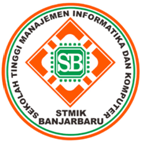Uji Kontrol Sistem Penerangan Bangunan Non IoT Berbasis Komunikasi Nirkabel Wi-Fi
Abstract
People desperately need the efficiency of time, energy, and cost in their daily lives. Therefore various efforts are made to be achieved, and one of them is by utilizing a smartphone or smartphone device. One of the applications developed and based on the Android operating system is on automation, whether for lighting houses, buildings, etc. Especially in the building lighting system, the problem is when the building guard forgets to turn off one or more lights. It isn't easy when the building guard has to return to the light switch position, especially in a multi-storey building, and he or she is already in the lobby (ground floor).
This research has designed the build of a system to control the lighting lights of buildings. Some devices serve as command givers (android phones), and there are command recipients (microcontrollers). The type of connection used is Wi-Fi wireless communication between the microcontroller and the smartphone without utilizing an internet connection (IoT). The enhancements used are access points to bridge communication from the mobile phone to the command receiver module.
The system's test results designed to build have found good performance in multi-storey buildings (three storeys). Among them is that the system implemented using wireless communication (Wi-Fi) with a control distance of approximately 12 meters without interference from other mobile
Keywords : building lighting system; wemosD1;Â Wi-Fi; microcontroller; Android;
Abstrak
Manusia sangat membutuhkan adanya efisiensi waktu, tenaga, dan biaya di kehidupan sehari harinya. Karenanya berbagai upaya dilakukan agar hal itu dapat dicapai, dan salah satunya adalah dengan memanfaatkan perangkat telepon pintar atau smart phone. Salah satu aplikasi yang dikembangkan dan berbasis sistem operasi android adalah pada otomasi, baik untuk penerangan rumah, gedung, dan atau yang lainnya. Khusus pada sistem penerangan gedung, persoalan yang dihadapi adalah pada ketika penjaga gedung lupa mematikan satu lampu atau lebih. Hal ini akan menyulitkannya ketika harus kembali ke posisi saklar lampu tersebut berada, apalagi pada gedung bertingkat dan saat itu penjaga gedung sudah berada di lobby (lantai dasar).
Penelitian ini telah merancang bangun sebuah sistem untuk melakukan pengontrolan lampu penerangan gedung. Ada perangkat yang berfungsi sebagai pemberi perintah (handphone android) dan ada penerima perintah (mikrokontroler). Jenis koneksi yang digunakan adalah komunikasi nirkabel Wi-Fi antara mikrokontroller dan smartphone tanpa memanfaatkan koneksi internet (IoT). Perangkat tambahan yang digunakan adalah akses poin untuk menjembatani komunikasi dari handphone ke modul penerima perintah.
Hasil pengujian terhadap sistem yang dirancang bangun telah mendapati kinerja yang baik pada gedung bertingkat (berlantai tiga) dengan variasi jarak kontrol terhadap lampu sejauh 2 s.d. 9 meter. Hal ini tergantung daya sinyal Wi-Fi yang ditangkap dan ada atau kuat tidaknya gangguan dari sinyal Wi-Fi lainnya.
Kata kunci: sistem penerangan gedung; wemosD1;Â Wi-Fi; mikrokontroler; Android;
References
Aditya, F.G., Hafidudin, Permana, A.G. “Analysis and Design of Prototype Smart Home With Client Server System Based Android Platrform Through Wireless Communication,†e-Proceeding Eng., 2015, 1(2): 3070–3077
Baig, I., Muzamil, C., & Dalvi, S. “HOME AUTOMATION USING ARDUINO WIFI MODULE ESP8266,†ANJUMAN-I-ISLAM’S KALSEKAR TECHNICAL CAMPUS PANVEL, 2016.
Kurniawan, “PURWA RUPA IoT (Internet of Things) KENDALI LAMPU GEDUNG (Studi Kasus pada Gedung Perpustakaan Universitas Lampung),†UNIVERSITAS LAMPUNG, 2016.
Laidi, R., Djenouri, D., & Ringel, M. (2019). Commercial technologies for advanced light control in smart building energy management systems: a comparative study. ,†Energy Power Eng., 2019, 11(8): 283–302
Maulida, T., B. Rahmani, “RANCANG BANGUN ALAT KENDALI PENERANGAN RUMAH TINGGAL BERBASIS ARDUINO UNO DAN JALUR KOMUNIKASI NIRKABEL MENGGUNAKAN METODE RESPON OTONOM,†STMIK BANJARBARU, 2020.
Muslihudin, M., Renvillia, W., Taufiq, T., Andoyo, A., & Susanto, F. Implementasi Aplikasi Rumah Pintar Berbasis Android Dengan Arduino Microcontroller. Jurnal Keteknikan dan Sains (JUTEKS), 2018, 1(1): 23-31.
Prasiska, A.). “MODEL KONTROL PENERANGAN BANGUNAN BERBASIS,†STMIK Banjarbaru, 2021.
Sowah, R. A., Boahene, D. E., Owoh, D. C., Addo, R., Mills, G. A., Owusu-Banahene, W., ... & Sarkodie-Mensah, B. (2020). Design of a Secure Wireless Home Automation System with an Open Home Automation Bus (OpenHAB 2) Framework. Journal of Sensors, 2020: 1-22
Sumarna, I. K. T., Nugroho, S., Suryanto, A., & Sakti, D. V. S. Y. (2019). Rancang Bangun Kendali Lampu Menggunakan Wemos D1 Mini Dengan Pusat Kendali Media Sosial Telegram. Jurnal Komputasi, 2019, 7(2): 55-62
Susanto, A. Rancang Bangun Aplikasi Android Untuk Kontrol Lampu Gedung Menggunakan Media Bluetooth Berbasis Arduino Uno. Jurnal Teknik, 2019, 8(1): 1-7
Tharishny, S., Selvan, S., & Nair, P. (2016). Android based smart house control via wireless communication. International Journanl of Scientific Engineering and Technology, 2016, 5: 323-325.
Turang, D. A. O. Pengembangan Sistem Relay Pengendalian Dan Penghematan Pemakaian Lampu Berbasis Mobile. In Seminar Nasional Informatika (SEMNASIF), 2015, 1(1): 73-83
Vikram, N., Harish, K. S., Nihaal, M. S., Umesh, R., & Kumar, S. A. A. A low cost home automation system using Wi-Fi based wireless sensor network incorporating Internet of Things (IoT). In 2017 IEEE 7th International Advance Computing Conference (IACC) (pp. 174-178). IEEE., 2017
Yudhitya, R. “Perancangan SmartHouse Dengan Arduino Dan Android,†2014.
How To Cite This :
Refbacks
- There are currently no refbacks.










